At some point in your crypto journey, you must have heard of DeFi. Although most newbies have interpreted it as a cryptocurrency. DeFi is an acronym for Decentralized Finance, and it has a connection with the Ethereum network. So, what is DeFi in crypto? They are blockchain applications on the Ethereum network that helps to disrupt the activities of financial intermediaries, thus, no third party.
Since both Ethereum and DeFi are born of blockchain, they both use blockchain technologies to facilitate their activities. So, like every other cryptocurrency using blockchain technology, there are no third parties or a centralized body to execute transactions. DeFi is so popular because it allows the expansion in the use of blockchain technologies from running simple transactions to more complex financial benefits.
What’s the relationship between DeFi and Ethereum?
Ethereum is a cryptocurrency in the crypto world. However, DeFis are applications on the Ethereum network, since Ethereum can bear other decentralized applications built on its network. This is because Ethereum being the first successful smart contract crypto, could execute financial transactions and offers varying flexibilities. So, it’s safe to assume that there wouldn’t be DeFi in the first place without the Ethereum network.
What are DeFi application platforms?
In a nutshell, the DeFi application platform allows users to borrow or lend funds from one another, trade crypto, speculate price movements, carry out risk insurance and earn interests. Here are some of the most popular DeFi applications
DEXs (Decentralized exchanges): A typical online exchange platform helps users change their Fiat into cryptocurrencies. So, you could change your U.S dollars into Ethereum, etc. However, DEXs connect users to sellers so they can buy and sell directly without a third party.
Wrapped BTC: This is one of the most accessible means of sending bitcoin to the Ethereum network to use on the Ethereum DeFi network. So, it’s more of lending our bitcoin to get more commissions.
Lending platforms: They use smart contracts instead of intermediaries such as banks.
Also read: Decentralized Finance (DeFi) Projects Are Here to Stay, Don’t Miss Out
What is DeFi 2.0?
To fully grasp what DeFi 2.0 is, you need to first answer the question of what is DeFi in the crypto world? Once you can answer this and understand what DeFi is, getting the hang of 2.0 becomes easier. Recall that DeFi 1.0 is a decentralized financial system, and it’s the bedrock of the DeFi ecosystem. So what is DeFi 2.0? It’s an upgraded version of DeFi, and it aims to work on the weaknesses of the DeFi 1.0 and leverage its strengths. So, it’s a layer of application deployed on the initial DeFi protocol. One of the main reasons for this upgrade is to add liquidity to DeFi’s layers making it more sustainable.
What’s the importance of DeFi 2.0?
As mentioned earlier, DeFi 2.0 is an upgrade of DeFi, and an upgrade would definitely improve on the weaknesses of the previous application. In this case, the DeFi 1.0 needs to improve on sustainability, that being one of its weaknesses, hence, 2.0. Ultimately, the concept of liquidity was a crucial factor in developing the DeFi 2.0.
What’s the difference between DeFi and DeFi 2.0?
Thanks to Uniswap and Sushiswap, the DeFi 1.0 subversive capacity was quickly noticed as a huge difference in the whole crypto community. The decentralized finance community, through these exchangers, was able to prove its capabilities. But for technical engineers and blockchain technological advancements, we understood there are loopholes in the DeFi 1.0, and many technical teams were not satisfied with its cold architecture.
Unlike the DeFi 1.0, the 2.0 is more sustainable. The concept of sustainability is a core difference between them. The 2.0 upgrade layers deployed on the existing 1.0 to add more liquidity to its infrastructures. This, in turn, would increase DeFi 2.0’s sustainability of projects. The 2.0 upgrade has the following capabilities;
- Break the cold transaction mode, thereby allowing close advocacy between users. This will help them build close horizontal and form vertical string links.
- It would also add more driving force and vitality to the entire ecosystem in other to keep the liquidity mining pool active.
- The members make bulks of the decisions since they are more or less the stakeholders as well.
The DeFi 1.0 and 2.0 protocols matter significantly; although 2.0 is an upgrade of 1.0, they still share some characteristics. Nonetheless, the concept of Decentralized finance is a huge one, and one of the most straightforward means of understanding it is by visiting the Keytango website.










Leave a comment